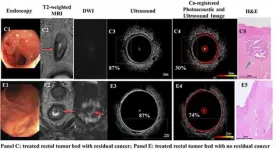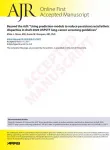Plasmon-coupled gold nanoparticles useful for thermal history sensing
2021-03-26
(Press-News.org) Researchers have demonstrated that stretching shape-memory polymers embedded with clusters of gold nanoparticles alters their plasmon-coupling, giving rise to desirable optical properties. One potential application for the material is a sensor that relies on optical properties to track an object or environment's thermal history.
At issue is a stretchable polymer embedded with gold nanospheres. If the material is heated and stretched, followed by cooling to room temperature, the material will hold its stretched shape indefinitely. Once reheated to 120 degrees Celsius, the material returns to its original shape.
But what's really interesting is that the gold nanospheres are not perfectly dispersed in the polymer. Instead, they form clusters, in which their surface plasmon resonances are coupled. These plasmon-coupled nanoparticles have optical properties that shift depending on how close they are to each other, which changes when stretching alters the shape of the composite.
"When assessing the peak wavelength of light absorbed by the material, there are significant differences depending on whether the light is polarized parallel or perpendicular to the stretching direction," says Joe Tracy, corresponding author of a paper on the work and a professor of materials science and engineering at NC State. "For light polarized parallel to the direction of stretching, the further you have stretched the material, the further the light absorbed shifts to the red. For light polarized perpendicular to the stretching direction there is a blueshift."
"We also found that, while the shape-memory polymer holds its shape at room temperature, it recovers its original shape in a predictable way, depending on the temperature it is exposed to," says Tobias Kraus, co-author of the paper, a group leader at the Leibniz Institute for New Materials and a professor at Saarland University.
Specifically, once stretched 140% past its original length, you can determine the highest temperature to which the polymer is then exposed, up to 120 degrees Celsius, by measuring how much it has shrunk back toward its original size. What's more, because of the plasmon-coupled nanoparticles, this change can be measured indirectly, through measurements of the material's optical properties.
"From a practical perspective, this allows you to create an optical thermal-history sensor," Joe Tracy says. "You can use light to see how hot the material got. An important application of thermal-history sensors is assuring the quality or safety of shipping or storing materials that are sensitive to significant changes in heat. We have demonstrated an approach based on plasmon coupling of gold nanoparticles."
The sensor concept was developed empirically, but the researchers also used computational modeling to better understand the structure of the clusters of gold nanospheres and how the clusters changed during stretching. The strength of plasmon coupling is related to the spacings between nanospheres, which is known as a "plasmon ruler."
"Based on our simulations, we can estimate the distance between plasmon-coupled nanoparticles from their optical properties," says Amy Oldenburg, co-author of the paper and a professor of physics at the University of North Carolina at Chapel Hill. "This comparison is informative for designing future polymer nanocomposites based on plasmon-coupled nanoparticles."
INFORMATION:
The paper, "Plasmon-Coupled Gold Nanoparticles in Stretched Shape-Memory Polymers for Mechanical/Thermal Sensing," appears in the journal ACS Applied Nano Materials. First author of the paper is Prachi Yadav, a former graduate student at NC State. The paper was co-authored by Mehedi Rizvi, Sumeet Mishra, Brian Chapman and Brian Lynch of NC State; and Björn Kuttich of the Leibniz Institute for New Materials.
The work was done with support from the National Science Foundation, under grants 1663416, 1803830 and 1803785; the National Institutes of Health, under grant R21 HL 130901; and the Alexander von Humboldt Foundation.
ELSE PRESS RELEASES FROM THIS DATE:
2021-03-26
A recent study published in JCI found that a neutrophil's endoplasmic reticulum, the organelle that normally makes proteins in the cell, becomes stressed in the autoimmune disorder lupus. This stress activates a molecule called IRE1α, which appears to play a critical role in lupus pathogenesis in mice.
A multidisciplinary research group at the University of Michigan, spanning microbiology, dermatology and rheumatology, discovered that IRE1α orchestrates the release of neutrophil extracellular traps, or NETs, from lupus neutrophils. NETs are sticky, spider web-like structures that cause inflammation when released at the wrong time or in the ...
2021-03-26
Research has found that obesity and mental disorders such as depression and anxiety seem to often go hand in hand. Researchers at Baylor College of Medicine and collaborating institutions are providing new insights into this association by identifying and characterizing a novel neural circuit that mediates the reciprocal control of feeding and psychological states in mouse models.
Similar to human patients, mice that consumed a high-fat diet not only became obese, but also anxious and depressed, a condition mediated by a defective brain circuit. When the researchers genetically ...
2021-03-26
Reactive oxygen species (ROS) cause oxidative stress at the cellular level. Research shows that this way, amongst others, they inhibit the germination capacity of plants, produce cytotoxins or exert toxic effects on aquatic invertebrates. Environmentally persistent free radicals (EPFR) are potential precursors of ROS because they can react with water to form these radical species. "Therefore, EPFR are associated with harmful effects on the ecosystem and human health," explains Gabriel Sigmund, the lead investigator of the study.
"Our study shows that these environmentally persistent free radicals ...
2021-03-26
Colorectal cancer risk does not rise after bariatric surgery, a study from the University of Gothenburg shows. This finding is important for patients with obesity, and their healthcare professionals, when deciding upon such an operation.
Obesity is a known risk factor for several types of cancer, including colorectal cancer (affecting the colon or rectum). It is already established that bariatric surgery leads to a decrease in overall cancer risk in patients with obesity.
However, some studies on colorectal cancer have shown an elevated cancer risk after bariatric surgery, while others have reported a risk reduction. ...
2021-03-26
The immune systems of all vertebrates contain specialized cells, called T cells, that play a fundamental role in protecting against fungal, bacterial, parasitic and viral infections. T cells use 'molecular sensors' called T cell receptors (TCRs) on their surface that can detect and eliminate the invading pathogens. For most of the past four decades, it was considered that there were only two T cell lineages, αβ and γδ T cells, characterized by their cell surface expressed αβ and γδ TCRs, respectively.
In a paper published today in Science, an international team of scientists at the University of New Mexico (US), Monash University (Australia), and the US National Institutes of Health, has defined a novel T cell lineage, called γμ ...
2021-03-26
Renewable energy demand and consumption is at an all-time high in the United States.
Shrub willow - a quick-growing woody crop - can be an excellent source of renewable bioenergy. The crop is harvested and turned into wood chips, which can be used for heat, mulch, animal bedding, biochar, and biofuel.
In a new study, researchers grew shrub willow on a semi-commercial scale to better understand the nuances of this bioenergy crop. The research was published in Agronomy Journal, a publication of the American Society of Agronomy.
"We learned and developed key know-hows that we can transfer to industry partners interested in this crop," says Armen Kemanian. Kemanian is a member of the American Society of Agronomy and is the ...
2021-03-26
Rectal cancer, along with colon cancer, is the third-most common type of cancer in the United States, and treatment and surgery greatly affect the quality of life of patients. A multi-disciplinary team at Washington University in St. Louis has developed and tested an innovative imaging technique that is able to differentiate between rectal tissues with residual cancers and those without tumors after chemotherapy and radiation, which could one day help to avoid unnecessary surgeries in some patients who have achieved complete tumor destruction after chemoradiation.
Quing Zhu, PhD, professor of biomedical engineering at the McKelvey School of Engineering, and members of her lab developed ...
2021-03-26
The Institute for Quality and Efficiency in Health Care (IQWiG) revised its methods paper and published the German original version "Allgemeine Methoden 6.0" (General Methods 6.0) on http://www.iqwig.de in November 2020. This document is the basis for the scientific work of the Institute and its external experts as well as for the collaboration with its contracting agencies, the Federal Joint Committee (G-BA) and Federal Ministry of Health (BMG). The English translation is now available on http://www.iqwig.de/en/about-us/methods/methods-paper/.
New features include statements on the investigation of the relationship between volume of services and quality, a section on different treatment periods in studies, and a more concrete approach to the assessment of clinical relevance.
In ...
2021-03-26
Scientists have developed a method to use lasers to control the movement of nanodiamonds with fluorescent centers.
Scientists have long been working on improving their ability to use lasers to move small objects without actually touching them. This method of 'optical trapping and manipulation' is already utilized in optics, biological sciences and chemistry. But objects become much more difficult to control once they grow to nanoscale size.
Now, a team of scientists including Hokkaido University's Keiji Sasaki and Osaka Prefecture University ...
2021-03-26
Leesburg, VA, March 26, 2021--According to ARRS' American Journal of Roentgenology (AJR), updated United States Preventive Services Task Force (USPSTF) lung cancer screening (LCS) guidelines based solely on age, pack-years, and quit-years perpetuate eligibility disparities among racial and ethnic minorities, although incorporating certain risk prediction models may help reduce such inequalities.
By pulling data from the 2015 National Health Interview Survey (NHIS), Journal of the National Cancer Institute researchers (Landy et al.) were able to "estimate the effects of USPSTF-2020 guidelines on disparities in LCS eligibility for the non-institutionalized civilian US population," wrote Massachusetts ...
LAST 30 PRESS RELEASES:
[Press-News.org] Plasmon-coupled gold nanoparticles useful for thermal history sensing




